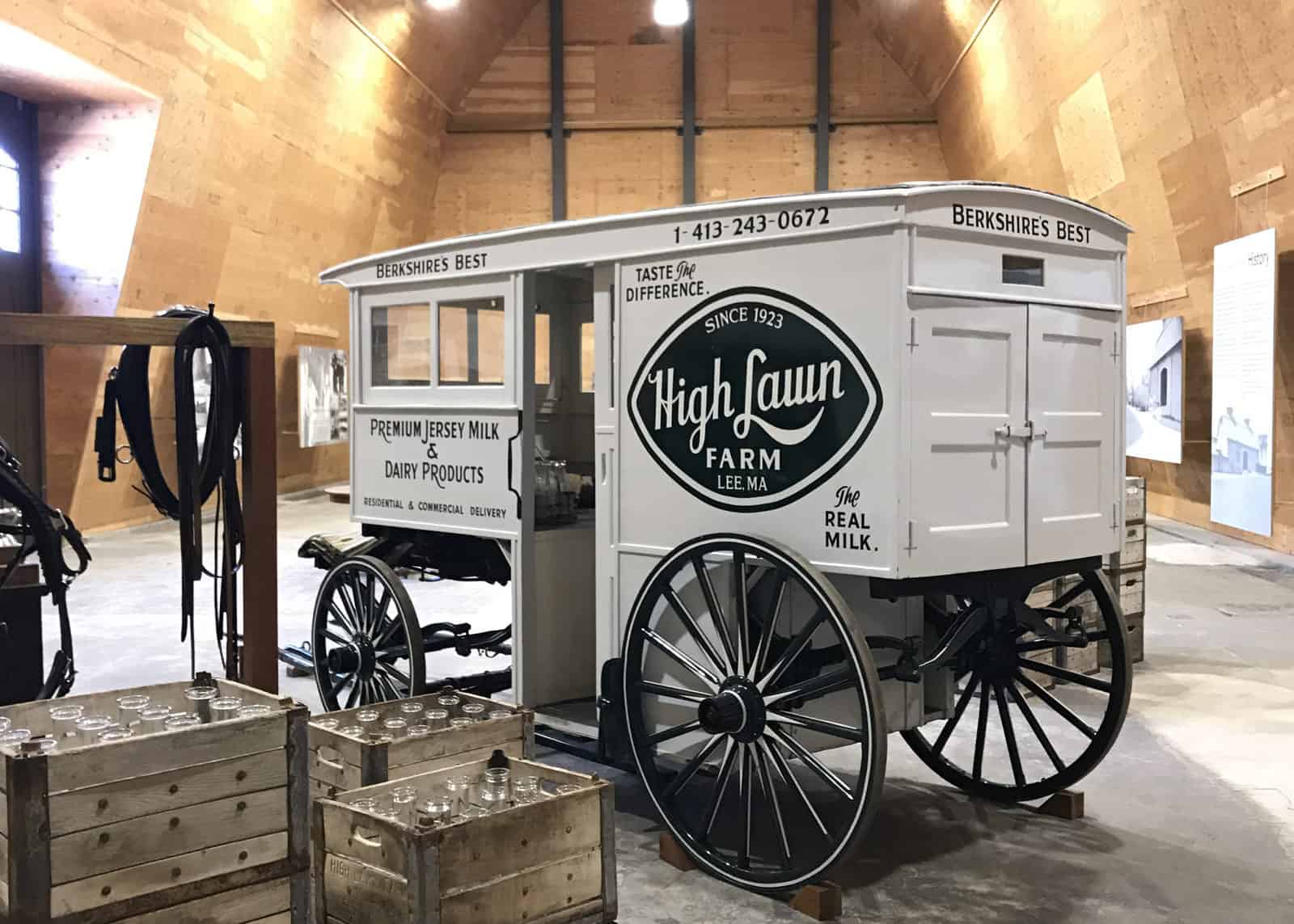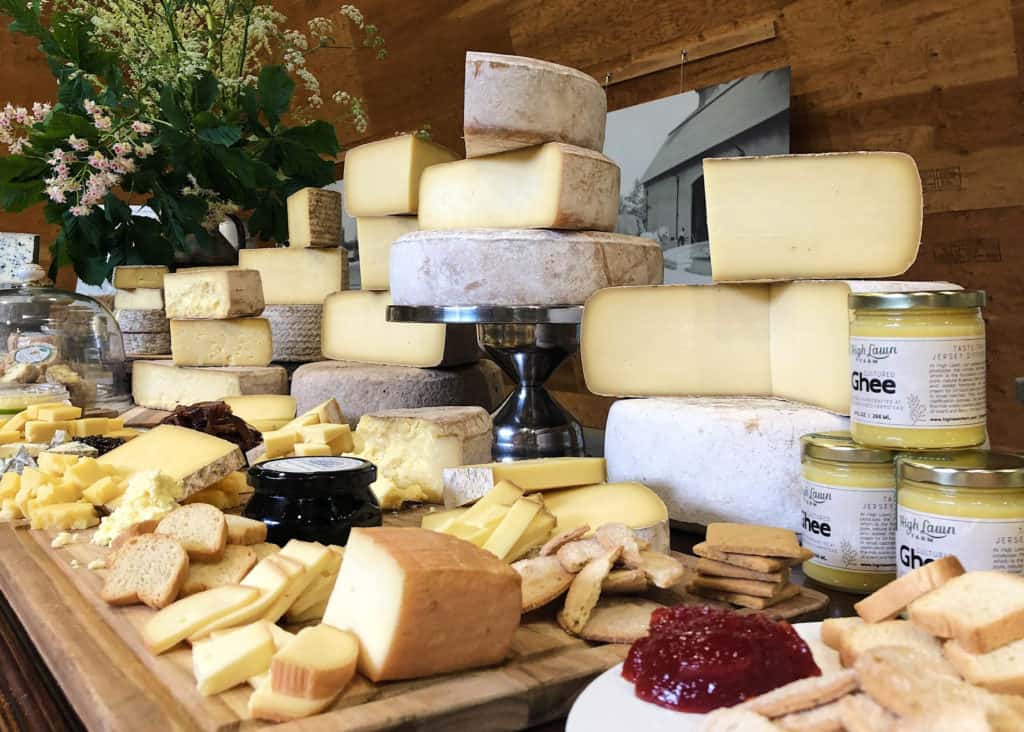
Photographed by Christine Burns Rudalevige
High Lawn Farm milk was a refrigerator staple in my Western Massachusetts childhood. Thrice weekly before dawn, Georgie (Bartini) The Milkman rolled up in his white delivery truck and exchanged the empty half-gallon glass bottles sitting on the side porch with ones filled with fresh Jersey cow’s milk from the 100-year-old dairy farm just up the road.
 We Burns kids were excellent milk drinkers. From a young age, we learned to taste the spring day when the cows went from noshing on hay in the barn to grazing on green pastures. While good local milk was always in our glasses, the local cheese on our crackers typically came from upstate New York or southern Vermont.
We Burns kids were excellent milk drinkers. From a young age, we learned to taste the spring day when the cows went from noshing on hay in the barn to grazing on green pastures. While good local milk was always in our glasses, the local cheese on our crackers typically came from upstate New York or southern Vermont.
The town of Lee is historically known for many things. Its name honors a Continental Army general from the Revolutionary War. Local farmers participating in Shay’s Rebellion scared off federal troops with a fake canon fashioned from a barn beam. Papermills there supplied wood pulp newsprint to The New York Times. Marble pulled from its quarries was fashioned into statues that adorn Philadelphia’s City Hall. Home to 6,000 people but just one set of traffic lights, Lee was dubbed the “Gateway to the Berkshires” because its exit off the Massachusetts Turnpike gives tourists easy access to the county’s cultural activities and scenic beauty.
Unfortunately for me, a turophile since before I knew that word existed, my hometown has never been known for its cheese. Until now, that is, because High Lawn Farm managers have turned to producing excellent aged cheeses, noteworthy soft bloomy rind varieties, a creamy, salty blue, cultured and clarified butters, and fanciful ice creams as value-added products to help sustain the farm in the wake of waning milk prices.
The buzz about these new cheeses—in production for two years and only on the market for a year now—across the Burns party line is consistently boastful.
“Seriously, Chrissy, they’re as good as those fancy cheeses you send me from New York on Father’s Day,” says my dad, life-long Lee resident and one-time High Lawn farmhand. We were sharing a wedge of High Lawn Cheddar, a dense, slightly crumbly aged cheese with a tangy buttermilk flavor, as we discussed how the town’s paper mills were being turning into aquaponic cannabis farms.

A cousin suggested on Facebook I try all of them, but ordered me not to miss Wilde Field, a sharp-tasting but chewy-textured cheese washed in a local IPA and aged three to eight months. High Lawn cheeses are named after people or cows that have made their mark on the farm. This one pays homage to Marjorie Field Wilde, who with her husband, Colonel H.G. Wilde, established the farm as a Jersey cow milk dairy in 1923. She was a pioneer in the field of Jersey breeding and due to her work, High Lawn Farm cows (currently numbering 120) are known to produce about four times as much milk with 17 percent more protein and 20 percent more calcium per unit of feed than average cows.
The farm is still owned by the Wilde family, with day-to-day operations handled by long-time General Manager Roberto Laurens Sr. In 2017, a multimillion-dollar renovation that included reconstructing a 1915 hay barn as well as a high-tech “at-will” cow milking system was completed. The farm added a half- a-million-dollar cheese making room and converted existing space into aging rooms in 2018.

My youngest brother, whose sense of humor is as wry and love for cheese is nearly as deep as my own, texted to say he’d never thought he’d be able to utter the words “Hey Dad, can you swing by High Lawn and get me some ghee before you visit me in D.C.?” He wanted to use the hometown ghee, clarified butter traditionally used in India, as the base ingredient in a mild curry he makes.
 Cheesemakers Robert Laurens, Jr. and Matt Schweizer attended workshops with artisan Vermont cheesemakers Peter Dixon of Parish Hill Creamery and Larry and Linda Faillace at Three Shepherds of the Mad River Valley to learn the basics of cheesemaking.
Cheesemakers Robert Laurens, Jr. and Matt Schweizer attended workshops with artisan Vermont cheesemakers Peter Dixon of Parish Hill Creamery and Larry and Linda Faillace at Three Shepherds of the Mad River Valley to learn the basics of cheesemaking.
“Then we worked around the clock making cheese. Our philosophy was to make all the mistakes we could at the start and learn from them fast,” says Laurens Jr., explaining how they process roughly 5,000 gallons of pasteurized milk into cheese three times a week. “Some of our mistakes actually turned into new and different cheeses that we’ll test the market for here in our on-site shop.”
High Lawn cheeses regularly on offer include Crema Alpina, a supple but sliceable Alpine cheese with a rind washed in Down East Cider from Maine; High Lawn Blue, a natural rind cheese with blue-green veining and a squishable texture; and Siegfried’s Pride, named after an award-winning cow, a semi-firm cheese that is rubbed with an herb-infused brandy as it ages 10 months.
The High Lawn cheese that has earned regional credibility is the High Lawn Queen, a bloomy rind wheel with a tangy, yeasty flavor. I spotted it in the specialty cheese case at the Portland, Maine, Whole Foods, where the cheese monger working the counter said she has trouble keeping it in stock. The cheese was originally named Comanche Queen after a High Lawn Farm heifer. But the company recently renamed it out of respect for The Comanche, who are firstly and foremostly a Native American nation. “I grew up on the milk from that farm!” I told the monger, hardly believing something so on trend came from my sleepy hometown.

WHERE TO BUY:
High Lawn Farm cheeses are always available online. They are also regularly stocked in Massachusetts at Guido’s Marketplace locations in Great Barrington and Lenox; Formaggio Kitchen locations around Boston; and Wasik’s Cheese Shop in Wellesley. But the best place to find the widest selection is at the hometown, shop on the farm, which is open every day between 10 a.m. and 7 p.m. (8 p.m. on weekends).




